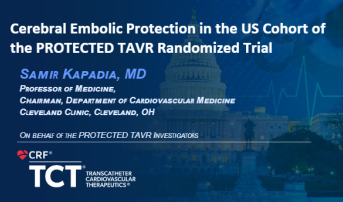Embolic Protection Benefits Varied by Geography in PROTECTED TAVR
The analysis wasn’t prespecified, and with no clear explanation, the field awaits insights from the larger BHF PROTECT-TAVI trial.

WASHINGTON, DC—An exploratory analysis of the PROTECTED TAVR trial suggests that use of the Sentinel cerebral embolic protection system (Boston Scientific) during TAVI had a greater impact in patients treated at US centers than at those outside the country.
Investigators, however, could not find any patient- or procedure-related factors that definitively explained the discrepancy.
Still, Samir Kapadia, MD (Cleveland Clinic, OH), told attendees of TCT 2024 here, “regional differences in patient characteristics and procedural practices may impact the effectiveness of the Sentinel device in reducing TAVR-related stroke.”
But because these subgroup analyses were not prespecified or powered to detect differences in clinical outcomes, the results should be considered hypothesis-generating, he said, adding that additional studies are needed to explore whether there are specific subsets of patients who might derive more benefit from cerebral embolic protection (CEP).
The results were published simultaneously online in JAMA Cardiology.
Though the Sentinel device has been shown to safely capture embolic debris in nearly all patients undergoing TAVI, leading to US Food and Drug Administration approval, it has not been proven to reduce clinical strokes. Observational studies, including a recent analysis from the Society of Thoracic Surgeons/American College of Cardiology TVT Registry, suggest that it does, although the impact may be small.
The PROTECTED TAVR investigators set out to get a more definitive answer, randomizing 3,000 patients to transfemoral TAVI with or without the Sentinel on board at 51 centers in North America, Europe, and Australia. The trial failed to meet its primary endpoint, showing no significant difference between the CEP and control arms in the occurrence of any stroke at 72 hours or before discharge (2.3% vs 2.9%; P = 0.30). There was a lower rate of disabling strokes, a nonpowered secondary endpoint, in the Sentinel arm (0.5% vs 1.3%; P =0.02).
There appeared to be a difference in outcomes depending on whether patients were treated in the US or elsewhere, although the interaction was not statistically significant. In the current exploratory analysis, Kapadia and his colleagues took a closer look at that possibility.
Overall, 61% of patients were treated in the US and 39% in Europe or Australia. Compared with those in other countries, US patients were younger on average (78 vs 81; P < 0.001), less likely to be female (37.4% vs 43.8%; P = 0.001), and less likely to be at extreme/high operative risk (24.4% vs 39.8%; P <0.001).
US patients also were more likely to have medically-treated diabetes and histories of peripheral vascular disease and CAD, but less likely to have a history of atrial fibrillation. Procedurally, use of balloon-expandable TAVI valves was more frequent in the US cohort (77.7% vs 42.4%) and predilation was less common (27.5% vs 60.1%; P < 0.001 for both).
In the US, CEP use was associated with a lower rate of any stroke (1.3% vs 2.6%; P = 0.045) and disabling stroke (0.4% vs 1.5%; P = 0.018). Outside the US, overall stroke rates were higher, and use of the Sentinel device was not associated with significantly different rates of any stroke (3.7% vs 3.3%; P = 0.662) or disabling stroke (0.7% vs 1.0%; P = 0.545). The geographic patterns were similar when looking only at ischemic strokes.
The researchers then looked at the discharge destinations for patients who left the hospital within 72 hours of having a stroke; US patients were more likely than those in other countries to get discharged within 3 days and to be sent home without services. Sentinel use was associated with a higher rate of discharge home in both the US patients (80% vs 50%) and those outside the country (60% vs 25%). This suggests fewer disabling strokes when the Sentinel is used, Kapadia said.
The problem is because you don’t have enough convincing evidence that it’s effective. Mohamed Abdel-Wahab
Among the patients who had a stroke and remained in the hospital for longer than 72 hours, the percentage discharged to the ICU or a stepdown unit was lower when CEP was used, but only in the US cohort (42.9% vs 85.7%).
“We looked at these regional differences to try to understand the patient population differences and procedural differences to see if we had any insight into saying why there were differences,” Kapadia said at a press conference. “And, unfortunately, we did not find one specific reason.”
Awaiting More Data
Mohamed Abdel-Wahab, MD, PhD (Helios Heart Centre, Leipzig, Germany), a PROTECTED TAVR investigator who was not involved in the current analysis, reflected on the difficulty of explaining the apparent geographic difference in outcomes. While one can hypothesize as to why the device seemed to work better in the US than in Europe, based on risk factors of the US population, you could equally come up with different explanations in Europe, had the findings been reversed, he said.
The variable geographic findings might be the result of how stroke is assessed post-TAVI, Abdel-Wahab said, suggesting that the higher overall rates of any stroke outside versus within the US might be an indication that neurologists there are picking up more minor strokes with unclear clinical significance. These minor strokes are probably not the types of events that will be stopped with CEP devices.
“The sensitivity of diagnosing stroke could be a confounding factor that could explain these regional differences,” he said.
In the US, Europe, and elsewhere, use of the Sentinel device during TAVI dipped after the primary PROTECTED TAVR results were released. Abdel-Wahab said at his center, one of the busiest in Europe, for instance, the proportion of TAVIs performed with CEP declined from 40-50% to 10-15%. He suggested that the price of the device had at least some bearing on the trend.
“Probably we would have been more liberal in using it because it’s a safe device, but it’s a costly device with no clear-cut evidence that we reduce stroke,” he said. Now, his team tries to use Sentinel in patients deemed to have a very high risk of stroke, such as those with a prior history of stroke and those with bicuspid valves.
Trying to select patients who may need protection from the device is a challenge, Abdel-Wahab acknowledged.
“The best thing for us as physicians would be to have a big trial that proves it’s effective and then we could use it in more patients,” he said, noting that the BHF-PROTECT TAVI trial, which is two-and-a-half times the size of PROTECTED TAVR, is ongoing and will provide additional insights into the impact of CEP.
“It’s a very user-friendly device. It’s very simple to use. It’s very safe, and it makes sense,” Abdel-Wahab said. “So if this device proves to be effective, everybody is going to use it. The problem is because you don’t have enough convincing evidence that it’s effective [and] as long as there is a cost issue, you cannot be very liberal in using it because you cannot justify it. And I don’t think that this paper can change this.”
Todd Neale is the Associate News Editor for TCTMD and a Senior Medical Journalist. He got his start in journalism at …
Read Full BioSources
Makkar RR, Gupta A, Waggoner TE, et al. Cerebral embolic protection by geographic region: a post hoc analysis of the PROTECTED TAVR randomized clinical trial. JAMA Cardiol. 2024;Epub ahead of print.
Disclosures
- The study was supported by Boston Scientific.
- Kapadia reports serving as principal investigator of studies sponsored by Boston Scientific without financial conflict.
- Abdel-Wahab reports receiving consulting fees/honoraria/speaking fees from Medtronic, Boston Scientific, and Shockwave Medical.






Hemal Gada